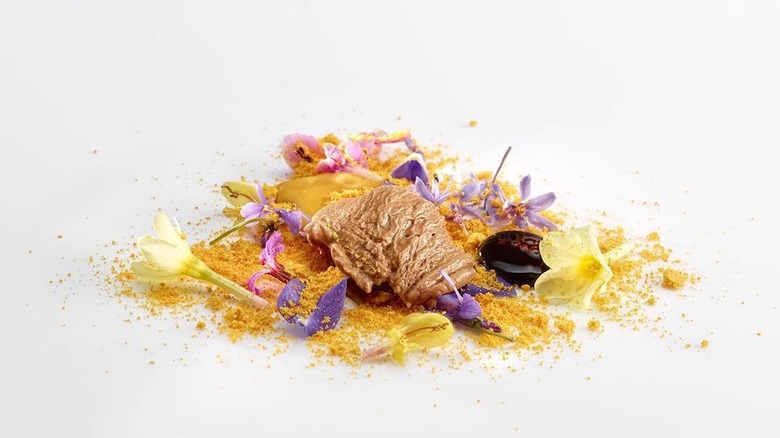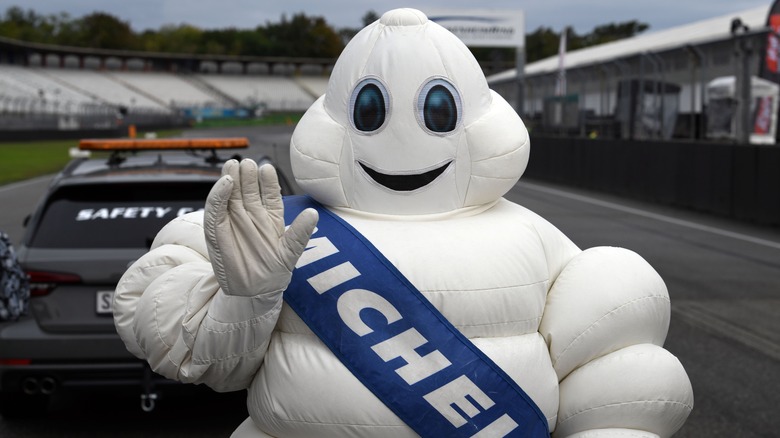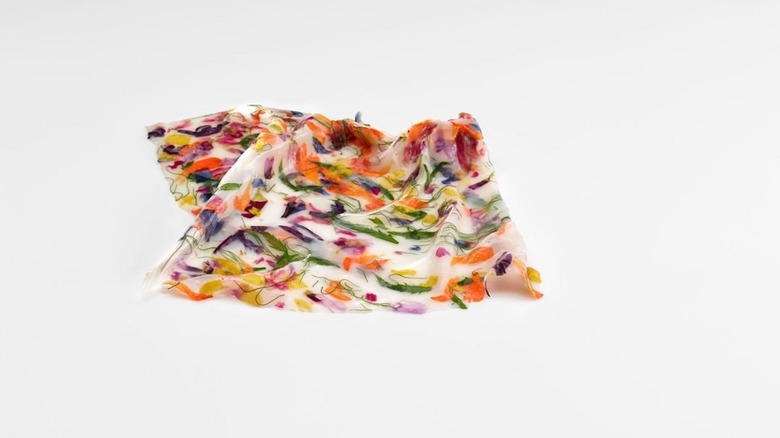The 'Rancid' Michelin Dish That Parodies The Michelin Man
Every so often, a chef shows up to throw a spatula into the fine dining works. As head chef of Mugaritz, a two-Michelin star restaurant in Errenteria, Spain, Andoni Luis Aduriz has never been afraid to take risks — in fact, he's even willing to make diners downright uneasy. That's why his Basque country house restaurant closes its doors for a full four months of the year in order to experiment with menus. This allows Aduriz and his team to devise challenging, trailblazing — and frankly weird — new dishes. And it earned Mugaritz 21st place in The World's 50 Best Restaurants 2022.
For instance, in 2012, Aduriz's "Edible Stones" was designed to make diners feel pretty uneasy, as it created the illusion that it might crack a tooth or two. As explained by Fine Dining Lovers, Mugaritz meticulously crafted grey ovals with the look and surface texture of river stones. But in fact, they were potatoes covered in crunchy edible clay, intended to melt into sweet creaminess in your mouth after a few moments — but not after a seemingly dicey first bite.
Likewise, his "blood macarons" (Macaron De Caza) challenged the usual idea of the classic French pastel confection. Because instead of the usual rose, pistachio, and chocolate flavors, these deep crimson macarons were made from wild game. In fact, the creation was a big enough culinary moment to warrant its own short film (via YouTube). But arguably, one of the restaurant's strangest dishes has to be the puzzling and surreal "Michelin Man."
Mugaritz's bizarro marshmallow soup course
It's easy to forget that the cheerful corporate mascot, the Michelin Man, shares the same roots as the prestigious Michelin Guide with its coveted star system for restaurants. But in fact, both exist under the umbrella of Michelin tire manufacturers, with the Michelin Guide starting in 1920 as a simple booklet for road travelers (via Michelin Guide). And as outlined by Logo Design Love, the Michelin Man himself — a jolly humanoid made entirely out of white tires — was first introduced to the public in 1898. The Michelin Guide even has a category of value-for-money restaurants named after him: the "Bib Gourmand" (because if you didn't know, his name is actually Bibendum).
As Mugaritz has maintained two Michelin stars since 2006, this was the likely inspiration for the restaurant's "Michelin Man" soup course. Essentially, it is the iconic mascot crafted out of toasted marshmallows, which sounds cutesy but as it's Aduriz, there's a sting to it. Described as a "toasted soup of oxidized wine" by Mugaritz, the Michelin Man is presented on a pool of said "rancid" wine (via Shane on the Go). It seems that he then dissolves into the dish while you are eating it, turning into a soup, hands clasped in a cadaver-like fashion. The effect is closer to a horror movie mummy than a happy-go-lucky corporate character, but what is the experience like for diners?
The mysterious motivations behind the Michelin Man dish
As pointed out by Fine Dining lovers, "very few palates appreciate the hit of rancid that comes with the oxidized sauce." It goes on to describe the dish as a "bitter-sweet swallow," suggesting that, despite the innocent marshmallow vibes, this is far from a comfort dish. However, Culinary Inspiration describes the concept as playfully eccentric, observing that the oxidized wine adds a sweet and tangy note.
So what exactly is chef Aduriz trying to say with his creation? Is he poking fun at the Michelin Guide in an affectionate way, by combining the two contrasting faces of the brand — avant-garde cuisine and cheerful mascot? Is he saying that his relationship with Michelin is bittersweet because, after all, those stars could be taken away at any time? Or is he challenging diners by depicting a beloved icon in a subtly disturbing fashion? The fact that the dish is mystifying and provokes discussion is part of Mugaritz's genius. This isn't just food to talk about — it's food to think about too.


